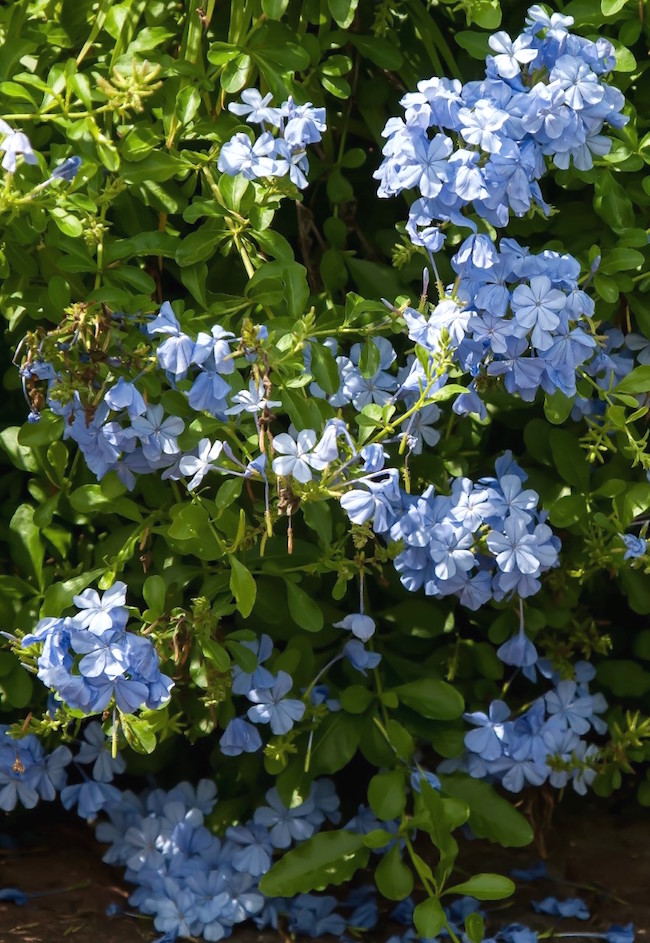Growing cape plumbago is like having your own ticket to the butterfly wild kingdom. Not only will you be the proprietor of the daily nectar café, but depending on where you live, you will also celebrate young ones, as this is a host plant for the cassius blue butterfly.
This comes from someone who has become a recent butterfly geek, if you will. If you are just a lover of color, then know you will be offered the rarest of blue for the garden from late spring through frost. This means that, whether you grow it as a returning perennial, shrub or treat it as an annual, you can relish the beauty of the sky blue flowers.
You might wonder why I am touting it now. The answer is that this South African native plant is tough as nails and a persevering performer, even in the torrid temperatures so prevalent during late August and early September. Botanically speaking, it is known as Plumbago auriculata. Its common names are “leadwort,” which I hate; “plumbago,” which is OK; and “cape plumbago,” which I like best.
The cape plumbago was chosen as a Texas Superstar plant in 2005, meaning it was promoted from the citrus area of the Lower Rio Grande Valley to the far north reaches of the Texas Panhandle. This also demonstrates that it can be grown in just about any good draining soil with most any pH.
We are growing ours at the Coastal Georgia Botanical Gardens at the Historic Bamboo Farm as a 36-inch tall shrub in full sun. It blooms on new growth and it will reward you with more blooms when you feel the need to shape it or prune lanky growth.
They are very tolerable of a partial-sun environment. We have experienced 18 and 22 degrees Fahrenheit in two of the three winters since I’ve been here, and our cape plumbagos have rebounded nicely. Most sources promote zone8b root hardiness, those in slightly colder zones are finding success with an added layer of mulch in the winter. Don’t forget that you can grow this rare-colored beauty as a terrific annual, too.
The sky blue color of the cape plumbago offers many choice partnerships, whether in mixed containers or in the garden. Over the years, I’ve seen them grown artistically with pink wave petunias. My favorite may be to see them combined with the rustic orange of the ‘Beyond Paradise’ copper plant or the fairly new ‘Campfire’ coleus. There is just something special about this blue and copper combination.
In much of the Savannah, Georgia, area, deer have become way more than a nuisance, and it gives me great happiness to say the cape plumbago is not on their menu. We grow ours with the yellow shrimp plant, Justicia brandegeeana, and ‘Black and Blue’ salvia, Salvia guaranitica, which are also both deer resistant.
In the last few days, we’ve had the cassius blue butterfly laying eggs, as well as various swallowtails and yellow, cloudless sulphur butterflies, which seems to be nature’s version of the complementary color scheme. We have also seen the hummingbird clearwing, a member of the hawk moth family.
There is one last plumbago I want to mention. Doctorbush is known botanically as Plumbago scandens. It is native to Arizona, Florida and Texas, and you occasionally find it or the named selection, ‘Summer Snow,’ at specialty garden centers. When I was the director of the National Butterfly Center in Mission, Texas, it fulfilled its mission, bringing in all sorts of butterflies, including the cassius blue.
Rare color, butterflies, deer resistance and summerlong performance are strong attributes of the award-winning cape plumbago. I hope you will give it a try and see if you agree that it is great value for your landscape dollar.
Follow me on Twitter @CGBGgardenguru. For more information about the Coastal Botanical Gardens, go to www.coastalgeorgiabg.org/.










